Okinawa Kenpo History
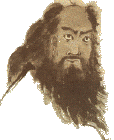 Most martial arts historians agree on the legend of a man who journeyed
across the Himalaya Mountains from India into China around 520 A.D.
His name is known as Bodhidharma (Daruma in Japanese). He
came to China to spread his philosophy of Buddhism. Bodhidharma
arrived in Honan ( Hunan ) province at the Shaolin temple,
only to find the monks practicing meditation, but in very weak
physical condition. In an effort to help the other monks withstand
many hours of meditation, he taught them breathing techniques and
several exercises to increase their stamina and build strength.
Most martial arts historians agree on the legend of a man who journeyed
across the Himalaya Mountains from India into China around 520 A.D.
His name is known as Bodhidharma (Daruma in Japanese). He
came to China to spread his philosophy of Buddhism. Bodhidharma
arrived in Honan ( Hunan ) province at the Shaolin temple,
only to find the monks practicing meditation, but in very weak
physical condition. In an effort to help the other monks withstand
many hours of meditation, he taught them breathing techniques and
several exercises to increase their stamina and build strength.
It is believed that
these same exercises, which were derived from imitating animals, are
the source of the Shaolin ch'uan-fa (fist law) or Shaolin
Temple Boxing. Using these exercises, the monks were able to develop
their spiritual and physical strength. The monks of the Shaolin
temple were known throughout China for their courage and fortitude.
This temple is
recognized by most martial artists as being the birthplace of gung-fu.
And Bodhidharma is sometimes called Tamo or Da Mo, and is
credited with originating gung-fu and karate. As these
fighting skills became famous, they spread to nearby Fukien
province, through tradesmen and merchants, and eventually to
Okinawa. Okinawa, known as the RyuKyu islands, is situated southwest
of the islands of Japan. Because of its strategic location between
Japan and China, both nations vied for domination of the island. In
the 14th century (1372) Okinawa became a Chinese satellite. It was
during this time that ch'uan fa (fist law) was probably
introduced. Chinese style fighting was greatly admired by the
Okinawans, and they began to merge it with an existing native form
of fighting called te (fist ), or bushi no te
(warrior's hand). At that time, this hybrid Okinawan martial
art was referred to by one of it's two names: To-de (Chinese
hands) or Kara-te.
Regarding
the use of the name Kara-te:
In China, there was a province by the name of Kara,
which was responsible for unifying the old country during the
Tang dynasty. It is believed that during the period of the Kara
Kingdom, Chinese martial arts leaked out to many satellite
countries (Japan, Okinawa, Korea, etc.). There are two ways of
writing in kanji, (kanji is one of the three
alphabets in Japan), the characters for the word karate. When
written one way, it reads "Chinese hands", and when
written the other way, it reads "empty hands". The kanji
for the "Chinese hands" may also be interpreted as
"Kara hands", or "hand of the Kara
Kingdom".
The Japanese later changed the kanji that read
"Chinese hands" to the kanji that reads
"empty hands". |
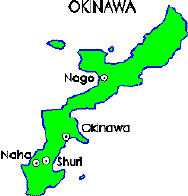 In
1429, an Okinawan by the name of Sho, Hashi united what was known as
the three kingdoms: Hokuzan (north), Chuzan (middle), and Nanzan
(south), and made his capital in the city of Shuri. In 1477, Sho,
Hashi was succeeded by another Okinawan by the name of Sho, Shin,
who put a stop to all feudalism on Okinawa, made all of the anji
(feudal lords) move to the capital city of Shuri and imposed a ban
on all weapons even rusty swords, by the peasant class. Sho-shin
encouraged people to focus on art and philosophy, so they might be
dissuaded from te. However, the martial art continued in
secrecy.
In
1429, an Okinawan by the name of Sho, Hashi united what was known as
the three kingdoms: Hokuzan (north), Chuzan (middle), and Nanzan
(south), and made his capital in the city of Shuri. In 1477, Sho,
Hashi was succeeded by another Okinawan by the name of Sho, Shin,
who put a stop to all feudalism on Okinawa, made all of the anji
(feudal lords) move to the capital city of Shuri and imposed a ban
on all weapons even rusty swords, by the peasant class. Sho-shin
encouraged people to focus on art and philosophy, so they might be
dissuaded from te. However, the martial art continued in
secrecy.
This was a good time
for Okinawa. The Ryukyu kingdom expanded and prospered through trade
with China, Asia, Korea, and Japan. Then, in 1609, the reigning king
of the dynasty found himself obliged to outfit an army for sake of
repelling an invasion of the islands that had been launched by
Shimazu, the daimyo of the clan of Satsuma, who had been exiled from
Japan. The newly armed Ryukyuan warriors fought with conspicuous
bravery and gallantry against the soldiers of the Satsuma clan,
known and feared throughout the country for their fighting skill,
but, after Ryukyuan success in a few pitched battles, a surprise
landing by Shimazu's forces sealed the fate both of the islands and
of their monarch, who was forced to surrender. The Sansura clan of
Japan invaded and took over control of Okinawa. Shimazu reissued the
edict banning weapons.
Okinawan Ch'uan fa
groups and To-de societies banded together to produce a solid front
against the Japanese . Many Okinawans were secretly sent to China to
learn fighting arts. Okinawa for many centuries engaged in trade
with the people of Fukien province in southern China, and it is
probably from this source that Chinese kempo ("boxing")
was introduced into the islands. As well as empty handed fighting,
the use of the Bo,
Sai,
Tonfa,
Nunchaku,
Kama, and other farm and
household items were secretly developed into effective weapons with
their own individual methods or system. Combined, these weapons
systems are known as
kobudo.
 During
the 1700s, an officer called Sakugawa, who was in the
Okinawan Palace Guard, learned Chinese fighting from a Chinese
military officer, Kusanku, who arrived in Okinawa in 1761. At
this time of Japanese occupation, it was still permitted for some
Chinese attaches to come and go in Okinawa, for envoy purposes. It
was also allowed for the nobles or royal classes to practice To-te,
and it was definitely a requirement for the Royal Guard ). Sakugawa
traveled many times to China with Kusanku, and learned to
combine Ch'uan fa with te to form Okinawan-te.
In fact, Sakugawa's nick-name was "karate"
or To-te" Sakugawa ( sometimes spelled ' To-de'
), which literally meant, "Chinese fist Sakugawa."
The name karate, in those days, meant, "Chinese hand".
Later on in Japan, the character for "Chinese," was
changed to one meaning "empty," so the new translation
meant "empty hand." ( From Kusanku we have the name
of two high level katas, Kusanku Sho
and Kusanku Dai, which is interesting because Kusanku
supposedly did not teach kata! The
katas
may have been formed from the techniques taught by Kusanku).
During
the 1700s, an officer called Sakugawa, who was in the
Okinawan Palace Guard, learned Chinese fighting from a Chinese
military officer, Kusanku, who arrived in Okinawa in 1761. At
this time of Japanese occupation, it was still permitted for some
Chinese attaches to come and go in Okinawa, for envoy purposes. It
was also allowed for the nobles or royal classes to practice To-te,
and it was definitely a requirement for the Royal Guard ). Sakugawa
traveled many times to China with Kusanku, and learned to
combine Ch'uan fa with te to form Okinawan-te.
In fact, Sakugawa's nick-name was "karate"
or To-te" Sakugawa ( sometimes spelled ' To-de'
), which literally meant, "Chinese fist Sakugawa."
The name karate, in those days, meant, "Chinese hand".
Later on in Japan, the character for "Chinese," was
changed to one meaning "empty," so the new translation
meant "empty hand." ( From Kusanku we have the name
of two high level katas, Kusanku Sho
and Kusanku Dai, which is interesting because Kusanku
supposedly did not teach kata! The
katas
may have been formed from the techniques taught by Kusanku).
 In
1904, karate became even more popular with it's introduction to the
Okinawan public schools. The man responsible for this was Yatasune
"Anko" Itosu, who helped make karate part of the physical
education requirements. Yatasune "Anko" Itosu ( "Anko,"
means 'horse,' and referred to the horse stance at which Itosu was
superb in demonstrating ) was an educator in Shuri, a south city in
Okinawa. Itosu was born in 1830 into a shizoku, or noble
family. He became an educator, but was also a learned master of
karate. From Itosu came the Pinan katas. These katas
were stated by one source as coming from the Kusanku kata,
before it was broken down into Sho ( lesser ) and Dai
( greater ). However, another source says that Itosu learned a form
from a Chinese man, and the form was called "Chiang Nan"
or ( Channan in Okinawan pronunciation ) from which he produced the Pinan
katas.
In
1904, karate became even more popular with it's introduction to the
Okinawan public schools. The man responsible for this was Yatasune
"Anko" Itosu, who helped make karate part of the physical
education requirements. Yatasune "Anko" Itosu ( "Anko,"
means 'horse,' and referred to the horse stance at which Itosu was
superb in demonstrating ) was an educator in Shuri, a south city in
Okinawa. Itosu was born in 1830 into a shizoku, or noble
family. He became an educator, but was also a learned master of
karate. From Itosu came the Pinan katas. These katas
were stated by one source as coming from the Kusanku kata,
before it was broken down into Sho ( lesser ) and Dai
( greater ). However, another source says that Itosu learned a form
from a Chinese man, and the form was called "Chiang Nan"
or ( Channan in Okinawan pronunciation ) from which he produced the Pinan
katas.
Itosu taught anyone who
wanted to learn, in contrast to some of the other masters, who would
not permit a student to learn from more than one teacher. According
to Gichin Funakoshi, student of Itosu and founder of Shotokan
karate, Itosu was of average height, with a great round chest like a
beer barrel. Despite his long moustache, he rather had the look of a
well-behaved child. Itosu was so well trained that his entire body
seemed to be invulnerable. Once, as he was about to enter a
restaurant in Naha ( near Shuri), a sturdy young man attacked him
from the rear, aiming a blow at his side. But Itosu, without even
turning, hardened the muscles of his stomach so that the blow
glanced off his body, and at the very same instant his right hand
grasped the right wrist of his assailant. Still without turning his
head, he calmly dragged the man inside the restaurant.
There, he ordered the
frightened waitresses to bring food and wine. Still holding the
man's wrist with his right hand, he took a sip of the wine from the
cup that he held in his left hand, then pulled his assailant around
in front of him and for the first time had a look at him. After a
moment, he smiled and said, "I don't know what your grudge
against me could be, but let's have a drink together!" The
young man's astonishment at this behavior can easily be imagined.
Itosu had another
famous encounter with a rash young man, this one the karate
instructor of a certain Okinawan school. Belligerent by nature and
full of pride at his strength, the youth had the rather unpleasant
habit of lurking in dark lanes, and when a lonely walker happened to
come strolling by, he would lash out at the poor soul. So
self-confident did he finally become that he decided to take on
Itosu himself, believing that, no matter how powerful the master
was, he could be beaten if set upon unawares.
One night, he followed
Itosu down the street and, after a stealthy approach, aimed his
strongest punch at the master's back. Bewildered by the quite
evident fact that he had made no impression whatsoever, the young
bully lost his balance and at that same instant felt his right wrist
caught in a viselike grip. Now Itosu had very strong hands, able to
crush a thick bamboo stem in his bare hand, as attested by Funakoshi
himself. The youth now tried to free himself with his other hand,
but of course he did not succeed. Itosu now walked on, hauling the
other behind him without even bothering to look back. Realizing that
he had failed completely, the young man begged the master's
forgiveness. "But who are you?" Itosu asked softly.
"I'm Goro," replied the youth. Now Itosu looked at him for
the first time. "Ah," he murmured, "you really
shouldn't try to play such tricks on an old man like me," With
that, he let go and strolled away.
Another time was from a
well-known incident when Itosu was set upon by a group of young
thugs, but before long the hoodlums were all lying unconscious in
the street. An eyewitness, seeing that Itosu was in no danger,
rushed off to tell Itosu's friend Azato what had transpired.
Interrupting his account, Azato said, "And the ruffians, of
course, were all lying unconscious, with their faces to the ground,
were they not?" Much surprised, the witness admitted that that
was true, but he wondered how Azato could have known. "Very
simple," replied the master. "No karate adept would be so
cowardly as to attack from the rear. And should someone unfamiliar
with karate attack from the front, he would end up flat on his back.
But I know Itosu; his punches would knock his assailants down on
their faces. I would be quite astonished if any of them survive.
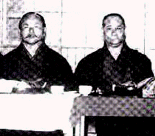 The
next development took place in 1922 at Tokyo and Osaka,
Japan. Two karate men, Funakoshi, Gichin and Motobu, Choki,
gave a demonstration of Okinawan karate for Japanese approval. Funakoshi
impressed the emperor Horohito so much, that by 1932, karate
became part of the educational system of Japan. After his
demonstration, Funakoshi was asked to stay in Japan and teach
Okinawan karate-do. Even though it meant many years of
separation from his wife, Funakoshi agreed to stay and teach
at one of the local universities. The karate-do as Funakoshi
knew it would have to change in order for his Japanese students to
understand it's complexity. Stances were altered and names of katas
changed. His new system was titled Shoto-kan, but Funakoshi
disliked the name; he thought that all karate should be the same.
The
next development took place in 1922 at Tokyo and Osaka,
Japan. Two karate men, Funakoshi, Gichin and Motobu, Choki,
gave a demonstration of Okinawan karate for Japanese approval. Funakoshi
impressed the emperor Horohito so much, that by 1932, karate
became part of the educational system of Japan. After his
demonstration, Funakoshi was asked to stay in Japan and teach
Okinawan karate-do. Even though it meant many years of
separation from his wife, Funakoshi agreed to stay and teach
at one of the local universities. The karate-do as Funakoshi
knew it would have to change in order for his Japanese students to
understand it's complexity. Stances were altered and names of katas
changed. His new system was titled Shoto-kan, but Funakoshi
disliked the name; he thought that all karate should be the same.
At this time, the
Okinawan martial art was referred to by one of it's two names: To-de
(Chinese hands) or karate (Empty hands). The Okinawans wanted
everyone to agree on one name, so during a meeting between Miyagi,
Chojun; Hanashiro, Chomo; Motobu, Choki; and Kyan, Chotoku,
the decision was made and one name was finally agreed upon. In 1936,
the Okinawan martial art was given the name karate-do,
meaning "an empty-handed self defense art", or
"weaponless art of self defense." Some would even go on to
call it kute-do, ku meaning "sky", which was
associated with being "empty", and "te"
of course meaning hand.
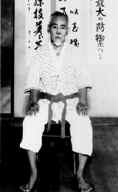 Master
Nakamura was born on Jan. 20, 1894. His karate training started
whilst in attendance of Icchu Middle School in Shuri. It was here
that both Kanryo Higashionna (1845-1915) and Chomo Hanashiro
(1830-1945) were the karate instructors. Yatasune Itosu (1830-1915)
as well as Kentsu Yabu (1863-1937) also made visits to the school.
Upon Graduation from middle school, Nakamura Sensei returned to Nago
city where he continued his training under Shinkichi Kunioshi,
the successor to the legendary Naha "Bushi"
Sakiyama. In 1953, Nakamura Sensei opened his own
dojo in Nago city where he called his form of karate "Okinawa
Kenpo". Later, Master Nakamura gained
additional fame for his introduction of "bogu gear",
protective equipment permitting full contact sparring.
Master
Nakamura was born on Jan. 20, 1894. His karate training started
whilst in attendance of Icchu Middle School in Shuri. It was here
that both Kanryo Higashionna (1845-1915) and Chomo Hanashiro
(1830-1945) were the karate instructors. Yatasune Itosu (1830-1915)
as well as Kentsu Yabu (1863-1937) also made visits to the school.
Upon Graduation from middle school, Nakamura Sensei returned to Nago
city where he continued his training under Shinkichi Kunioshi,
the successor to the legendary Naha "Bushi"
Sakiyama. In 1953, Nakamura Sensei opened his own
dojo in Nago city where he called his form of karate "Okinawa
Kenpo". Later, Master Nakamura gained
additional fame for his introduction of "bogu gear",
protective equipment permitting full contact sparring.
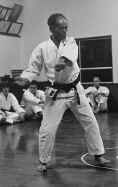 GRANDMASTER
SEIKICHI ODO
GRANDMASTER
SEIKICHI ODO
Seikichi
Odo, whose name means "world walker" in Japanese, was born
in Okinawa in 1926. Of samurai descent, he was small in stature and
introverted as a youth, making him the target of much teasing and
practical jokes by older boys. At age 9 Odo began his martial arts
training in Judo, but found it not to his particular tastes. At age
13 Odo met Koho Kuba of Kawasald, Okinawa. Kuba Sensei taught Odo
the art of Okinawa-te. At the age of 20, Odo began to study Okinawan
Kobudo. He was soon to fall in love with the weapons arts, and
studied them tediously to ensure the preservation of the old ways.
Over time, Odo's
kobudo
instructors included many of the leading practitioners of Okinawa,
such as Mitsuo Kakazu, Kenko Nakaima, Shimpo Matayoshi and, Seike
Toma. At 23 Odo began to study karate under Nakamura Sensei. Odo
studied both
kobudo
(with Mitsuo Kakazu) as well as karate and
kobudo
with Seike Toma, whom was a senior student of Chotoku Kyan
(1880-1945). However, Odo Sensei still considers Master Nakamura as
his primary instructor as well as mentor.
 It was during his
studies with Master Nakamura that Nakamura Sensei asked Odo to
incorporate the
kobudo
with Nakamura's own karate teachings. During the last few years of
Nakamura's life, Odo began to undertake the teaching
responsibilities of the dojo. Sensei Odo began to fully incorporate
kobudo
training with the Okinawa Kenpo Karate system in the mid 1970's.
This produced a new system, the Okinawa Kenpo Karate-Kobudo
Shudokan. The use of the word "shudokan"
is important to the development of this traditional fighting art
because it describes Master Odo's commitment to teaching.
Defined, "shudokan" means
"one way, keep straight, don't change."
It was during his
studies with Master Nakamura that Nakamura Sensei asked Odo to
incorporate the
kobudo
with Nakamura's own karate teachings. During the last few years of
Nakamura's life, Odo began to undertake the teaching
responsibilities of the dojo. Sensei Odo began to fully incorporate
kobudo
training with the Okinawa Kenpo Karate system in the mid 1970's.
This produced a new system, the Okinawa Kenpo Karate-Kobudo
Shudokan. The use of the word "shudokan"
is important to the development of this traditional fighting art
because it describes Master Odo's commitment to teaching.
Defined, "shudokan" means
"one way, keep straight, don't change."
DeValentino Shudokan Schools International (D.S.S.I.) is fortunate today
to have a link to the past; Okinawa Kenpo and Kobudo 10th dan Grand Master
(Hanshi) Odo, Seikichi (July 26, 1926 - March 24, 2002). Master
Odo was one of the worlds foremost weapons practitioners.
D.S.S.I. Director, Sensei DeValentino, studied for several years under
the late kyoshi Joseph A. Bunch of Honolulu and Hanshi Odo of Okinawa and
later became a direct student of Hanshi Odo in 1993
who personally examined and awarded Sensei Marcus DeValentino the 4th dan
in 1994, the 5th, dan in 1995, the Renshi (teacher license), and his sixth
degree Black Belt respectively in 1997.
http://okinawakenpodssi.com/certificates_and_licenses2020.htm
Due to politics, Marcus DeValentino resigned in 1998 after serving as
technical advisor and after carrying out the late grand master Seikichi Odo's
orders to legally dissolve his Okinawa Kenpo Karate Kobudo Federation to
re-establish it as the Ryukyu Hon Kenpo Kobujutsu Federation Odo of Okinawa
Japan. Marcus DeValentino continues independently to preserve the ancient
arts as International Director of the National Karate and Kobudo Federation,
as a member/instructor of Dragon Society International, and as
founder/director of DeValentino Shudokan Schools International (www.OkinawaKenpoDssi.com)
having developed some 300 Black Belts and some 3,000 students within the U.S.,
Hawaii, and Central America. The DSSI world training headquarters is
currently based in Hawaii.
 Return to Home Page
Return to Home Page
 Most martial arts historians agree on the legend of a man who journeyed
across the Himalaya Mountains from India into China around 520 A.D.
His name is known as Bodhidharma (Daruma in Japanese). He
came to China to spread his philosophy of Buddhism. Bodhidharma
arrived in Honan ( Hunan ) province at the Shaolin temple,
only to find the monks practicing meditation, but in very weak
physical condition. In an effort to help the other monks withstand
many hours of meditation, he taught them breathing techniques and
several exercises to increase their stamina and build strength.
Most martial arts historians agree on the legend of a man who journeyed
across the Himalaya Mountains from India into China around 520 A.D.
His name is known as Bodhidharma (Daruma in Japanese). He
came to China to spread his philosophy of Buddhism. Bodhidharma
arrived in Honan ( Hunan ) province at the Shaolin temple,
only to find the monks practicing meditation, but in very weak
physical condition. In an effort to help the other monks withstand
many hours of meditation, he taught them breathing techniques and
several exercises to increase their stamina and build strength. In
1429, an Okinawan by the name of Sho, Hashi united what was known as
the three kingdoms: Hokuzan (north), Chuzan (middle), and Nanzan
(south), and made his capital in the city of Shuri. In 1477, Sho,
Hashi was succeeded by another Okinawan by the name of Sho, Shin,
who put a stop to all feudalism on Okinawa, made all of the anji
(feudal lords) move to the capital city of Shuri and imposed a ban
on all weapons even rusty swords, by the peasant class. Sho-shin
encouraged people to focus on art and philosophy, so they might be
dissuaded from te. However, the martial art continued in
secrecy.
In
1429, an Okinawan by the name of Sho, Hashi united what was known as
the three kingdoms: Hokuzan (north), Chuzan (middle), and Nanzan
(south), and made his capital in the city of Shuri. In 1477, Sho,
Hashi was succeeded by another Okinawan by the name of Sho, Shin,
who put a stop to all feudalism on Okinawa, made all of the anji
(feudal lords) move to the capital city of Shuri and imposed a ban
on all weapons even rusty swords, by the peasant class. Sho-shin
encouraged people to focus on art and philosophy, so they might be
dissuaded from te. However, the martial art continued in
secrecy.
 In
1904, karate became even more popular with it's introduction to the
Okinawan public schools. The man responsible for this was Yatasune
"Anko" Itosu, who helped make karate part of the physical
education requirements. Yatasune "Anko" Itosu ( "Anko,"
means 'horse,' and referred to the horse stance at which Itosu was
superb in demonstrating ) was an educator in Shuri, a south city in
Okinawa. Itosu was born in 1830 into a shizoku, or noble
family. He became an educator, but was also a learned master of
karate. From Itosu came the Pinan katas. These katas
were stated by one source as coming from the Kusanku kata,
before it was broken down into Sho ( lesser ) and Dai
( greater ). However, another source says that Itosu learned a form
from a Chinese man, and the form was called "Chiang Nan"
or ( Channan in Okinawan pronunciation ) from which he produced the Pinan
katas.
In
1904, karate became even more popular with it's introduction to the
Okinawan public schools. The man responsible for this was Yatasune
"Anko" Itosu, who helped make karate part of the physical
education requirements. Yatasune "Anko" Itosu ( "Anko,"
means 'horse,' and referred to the horse stance at which Itosu was
superb in demonstrating ) was an educator in Shuri, a south city in
Okinawa. Itosu was born in 1830 into a shizoku, or noble
family. He became an educator, but was also a learned master of
karate. From Itosu came the Pinan katas. These katas
were stated by one source as coming from the Kusanku kata,
before it was broken down into Sho ( lesser ) and Dai
( greater ). However, another source says that Itosu learned a form
from a Chinese man, and the form was called "Chiang Nan"
or ( Channan in Okinawan pronunciation ) from which he produced the Pinan
katas.
 Master
Nakamura was born on Jan. 20, 1894. His karate training started
whilst in attendance of Icchu Middle School in Shuri. It was here
that both Kanryo Higashionna (1845-1915) and Chomo Hanashiro
(1830-1945) were the karate instructors. Yatasune Itosu (1830-1915)
as well as Kentsu Yabu (1863-1937) also made visits to the school.
Upon Graduation from middle school, Nakamura Sensei returned to Nago
city where he continued his training under Shinkichi Kunioshi,
the successor to the legendary Naha "Bushi"
Sakiyama. In 1953, Nakamura Sensei opened his own
dojo in Nago city where he called his form of karate "Okinawa
Kenpo". Later, Master Nakamura gained
additional fame for his introduction of "bogu gear",
protective equipment permitting full contact sparring.
Master
Nakamura was born on Jan. 20, 1894. His karate training started
whilst in attendance of Icchu Middle School in Shuri. It was here
that both Kanryo Higashionna (1845-1915) and Chomo Hanashiro
(1830-1945) were the karate instructors. Yatasune Itosu (1830-1915)
as well as Kentsu Yabu (1863-1937) also made visits to the school.
Upon Graduation from middle school, Nakamura Sensei returned to Nago
city where he continued his training under Shinkichi Kunioshi,
the successor to the legendary Naha "Bushi"
Sakiyama. In 1953, Nakamura Sensei opened his own
dojo in Nago city where he called his form of karate "Okinawa
Kenpo". Later, Master Nakamura gained
additional fame for his introduction of "bogu gear",
protective equipment permitting full contact sparring.

 Return to Home Page
Return to Home Page